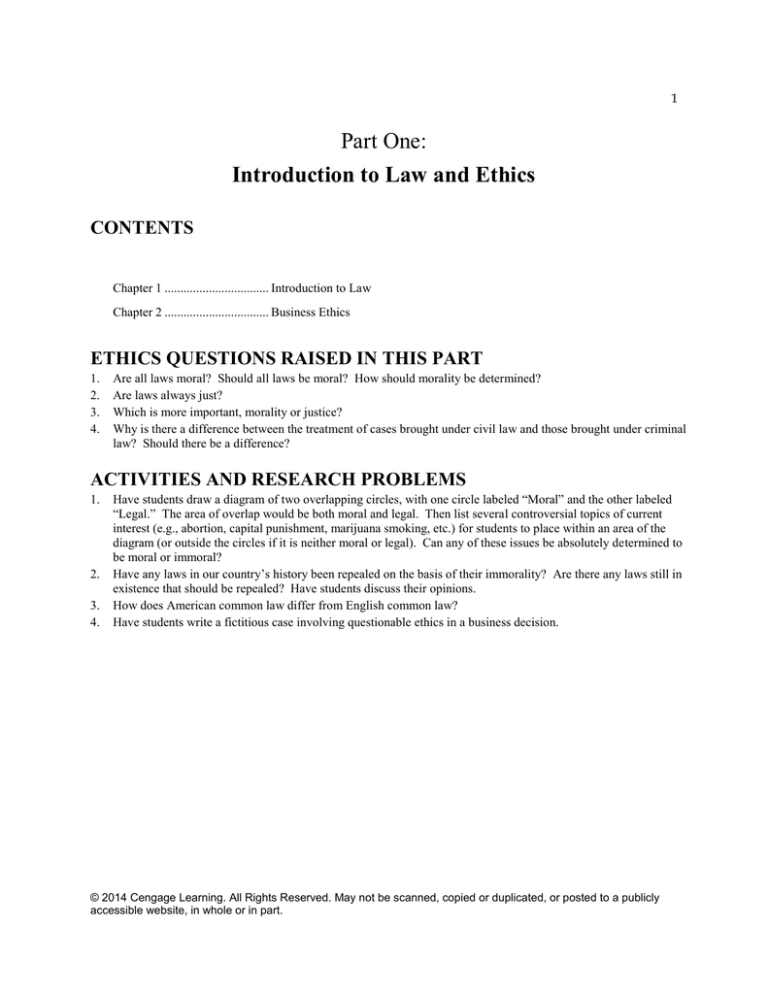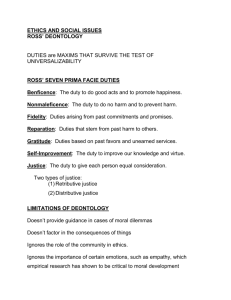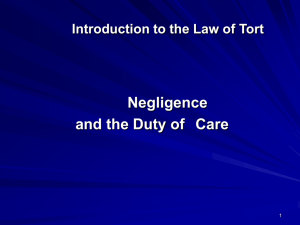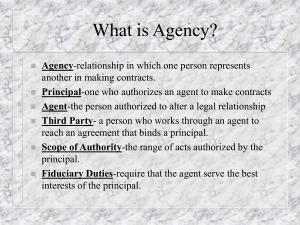
1
Part One:
Introduction to Law and Ethics
CONTENTS
Chapter 1 ................................. Introduction to Law
Chapter 2 ................................. Business Ethics
ETHICS QUESTIONS RAISED IN THIS PART
1.
2.
3.
4.
Are all laws moral? Should all laws be moral? How should morality be determined?
Are laws always just?
Which is more important, morality or justice?
Why is there a difference between the treatment of cases brought under civil law and those brought under criminal
law? Should there be a difference?
ACTIVITIES AND RESEARCH PROBLEMS
1.
2.
3.
4.
Have students draw a diagram of two overlapping circles, with one circle labeled “Moral” and the other labeled
“Legal.” The area of overlap would be both moral and legal. Then list several controversial topics of current
interest (e.g., abortion, capital punishment, marijuana smoking, etc.) for students to place within an area of the
diagram (or outside the circles if it is neither moral or legal). Can any of these issues be absolutely determined to
be moral or immoral?
Have any laws in our country’s history been repealed on the basis of their immorality? Are there any laws still in
existence that should be repealed? Have students discuss their opinions.
How does American common law differ from English common law?
Have students write a fictitious case involving questionable ethics in a business decision.
© 2014 Cengage Learning. All Rights Reserved. May not be scanned, copied or duplicated, or posted to a publicly
accessible website, in whole or in part.
2
Chapter 1
INTRODUCTION TO LAW
A. Nature of Law
1. Definition of Law
2. Functions of Law
3. Law and Morals
4. Law and Justice
B. Classification of Law
1. Substantive and Procedural Law
2. Public and Private Law
3. Civil and Criminal Law
C. Sources of Law
1. Constitutional Law
2. Judicial Law
a. Common Law
b. Equity
c. Restatements of Law
3. Legislative Law
a. Treaties
b. Executive Orders
4. Administrative Law
D. Legal Analysis
Cases in This Chapter
Caldwell v. Bechtel, Inc.
TEACHING NOTES
Law concerns the relations between and among individuals as those relations affect social and economic order.
It affects the rights and duties of every citizen and many non-citizens.
Law is both prohibitory, meaning certain acts must not be committed, and mandatory, meaning certain acts
must be done, sometimes in a set way. Additionally, law is permissive: certain acts are allowed, but not
required by the law.
A. NATURE OF LAW
The law is a continuously changing process of developing a workable set of rules that balance the individual
and group rights of an always-changing society.
Definition of Law
Legal scholars have defined law in various ways, including:
• “predictions of the way that a court will decide specific legal questions”
• “a rule of civil conduct prescribed by the supreme power in a state, commanding what is right, and
prohibiting what is wrong”
NOTE: See textbook for a description of the law’s essential characteristics, as defined by Roscoe Pound, a distinguished American jurist and
former dean of the Harvard Law School.
*** Chapter Objective ***
Identify and describe the basic functions of law.
© 2014 Cengage Learning. All Rights Reserved. May not be scanned, copied or duplicated, or posted to a publicly
accessible website, in whole or in part.
CHAPTER 1
INTRODUCTION TO LAW
3
Functions of Law
The functions of law are to maintain stability in the social, political, and economic system through (1) dispute
resolution, (2) protection of property, and (3) the preservation of the state while at the same time permitting
ordered change.
1. Disputes are inevitable in a complex society and may involve criminal or noncriminal matters. Law
provides rules to resolve disputes and avoid personal revenge.
2. Law protects ownership of property and allows for agreements (contracts) to exchange property. (This
text deals with many aspects of this including contracts, sales, commercial paper, and business
associations.)
3. Law preserves the state. It ensures that changes are result of elections, legislation, and referenda rather
than revolution, sedition, and rebellion.
*** Chapter Objective ***
Distinguish between law and justice. Distinguish between law and morals.
Law and Morals
Though law is affected by morals, law and morality are not the same. Some actions have no moral implications
but have legal sanctions, whereas other actions have no legal sanctions but do have moral implications. Some
actions have both moral impact and legal sanction.
NOTE: See Figure 1-1: Law and Morals.
Law and Justice
Law and justice are distinct but interrelated concepts.
• Justice may be defined as “the fair, equitable, and impartial treatment of the competing interests and
desires of individuals and groups, with due regard for the common good.”
• Justice depends on the law, but the law does not guarantee justice, since laws can be unjust. (Think
back to “legal” slavery and the “legal” actions of Nazi Germany.)
B. CLASSIFICATION OF LAW
Because the law is vast, it is helpful to organize it into categories such as: (1) substantive and procedural, (2)
public and private, and (3) civil and criminal.
Basic to understanding these classifications are the terms right and duty. A right is the ability of a person, with
the aid of the law, to require another person to perform or to refrain from performing a certain act. A duty is
the obligation the law imposes upon a person to perform or to refrain from performing a certain act. Duty and
right exist together: a person cannot have a right without some other person (or all persons) having the
corresponding duty.
NOTE: See textbook Figure 1-2, which outlines the classifications of law.
*** Chapter Objective ***
Distinguish between (a) substantive and procedural law, (b) public law and private law,
and (c) civil law and criminal law.
Substantive and Procedural Law
Substantive law creates, defines, and regulates legal rights and duties. Procedural law sets forth rules for
enforcing those rights that are created by the substantive law.
© 2014 Cengage Learning. All Rights Reserved. May not be scanned, copied or duplicated, or posted to a publicly
accessible website, in whole or in part.
4
INTRODUCTION TO LAW
CHAPTER 1
Public and Private Law
Public law is the branch of substantive law that deals with the government's rights and powers and its
relationship to individuals or groups.
Private law is that part of substantive law governing individuals and legal entities (such as corporations) in their
relationships with one another.
Civil and Criminal Law
Civil law defines duties and deals with the rights and duties of individuals among themselves. (It is part of
private law.)
NOTE: Civil law is not the same as a civil law system, discussed later in this chapter.
Criminal law establishes duties and involves offenses against a whole community. (It is part of public law.)
The purpose of the civil law is to compensate the injured party (plaintiff), while the purpose of criminal law is
to punish the wrongdoer. Typically, the civil law awards money for damages or an order for the defendant to
behave in a certain way, while criminal law imposes a fine or imprisonment on the guilty party.
*** Chapter Objectives ***
Identify and describe the sources of law. Explain the principle of stare decisis.
C. SOURCES OF LAW
•
•
•
•
•
•
•
•
Federal and state constitutions
Federal treaties (agreements between or among independent nations)
Interstate compacts
Federal and state statutes (laws passed by a legislative body such as the U.S. Congress or the
legislature of a state)
Executive orders (legislation issued by a President or governor)
Ordinances of local municipal governments
Rules and regulations of federal and state administrative agencies
Federal and state court decisions
NOTE: See Figure 1-3, Hierarchy of Law
Constitutional Law
A constitution sets forth the basic principles by which a government is guided, as well as the limitations on
governmental authority. The U.S. Constitution is the supreme law of the nation; a state constitution is the
highest law within that state. Federal law is supreme in cases of conflict with state law.
Fundamental principles of the U.S. Constitution include: Separation of Powers (division of power among
branches of government) and Judicial Review (power of the Supreme Court to determine constitutionality of
all laws).
Judicial Law
Common Law — Case decisions establish precedent in our common law system and must also be consulted
when researching a legal question. The principle of stare decisis requires that inferior courts stay consistent
with prior decisions of higher courts on cases with similar facts.
Equity — A supplementary system of judicial relief separate from the common law, based upon settled rules of
fairness, justice and honesty. Remedies include: specific performance, injunction, reformation, rescission,
and decree.
In most jurisdictions, a single court administers both common law and equity.
© 2014 Cengage Learning. All Rights Reserved. May not be scanned, copied or duplicated, or posted to a publicly
accessible website, in whole or in part.
CHAPTER 1
INTRODUCTION TO LAW
5
Restatements of Law — This is an orderly re-writing (or re-stating) of the general common law of the United
States; it is regarded as the authoritative statement of the common law of the United States. Covers many areas,
including torts, contracts, agency, property, and trusts.
Legislative (Statutory) Law
Legislative law consists of statutes passed by legislatures. Statutes may repeal judge-made law as long as the
statute is not unconstitutional. Legislatures have the freedom to choose the issues they want to address, and can
make or change laws relatively quickly. Courts may only address issues that are presented in actual cases,
leading to a more haphazard approach to establishing or revising laws.
The need for uniformity among state statutes led to the codification of large parts of business law. The most
successful example of this effort is the Uniform Commercial Code (UCC), prepared under the joint
sponsorship and direction of the National Conference of Commissioners on Uniform State Laws and the
American Law Institute. All fifty states, the District of Columbia, and the Virgin Islands have adopted the
UCC. (Louisiana has adopted only part of the UCC.)
Treaties — Agreements between or among independent nations; if signed by the President and approved by the
Senate, it has the legal force of a federal statute.
Executive Orders — The President has power to issue executive orders, which carry the authority of a law.
Administrative Law
The branch of public law that governs the powers and procedures of governmental entities (other than courts
and legislatures); often involves public health, safety and welfare. Administrative law is created by
administrative agencies in the form of rules, regulations, orders, and decisions to carry out the regulatory
powers and duties of those agencies.
D. LEGAL ANALYSIS
Decisions in state trial courts generally are not published but are filed in the office of the clerk of the court.
Decisions of state courts of appeals are published in volumes called “reports,” numbered consecutively. Some
states rely on a commercial reporter and no longer publish official reports. The decisions of courts in the federal
system are found in a number of reports.
For instance, Lefkowitz v. Great Minneapolis Surplus Store, Inc., 251 Minn. 188, 86 N.W.2d 689 (1957),
indicates that the opinion in this case may be found in Volume 251 of the official Minnesota Reports at page
188; and in Volume 86 of the North Western Reporter, Second Series, at page 689; and that the opinion was
delivered in 1957.
Normally, the reported opinion in a case includes:
1. the essential facts, the nature of the action, the parties, what happened to bring about the controversy,
what happened in the lower court, and what pleadings are material ;
2. the issues of law or fact;
3. the legal principles involved;
4. the application of these principles; and
5. the decision.
A serviceable method of analyzing and briefing cases after a careful reading and comprehension of the opinion
is for students to write in their own language a brief containing the following:
1. the facts of the case,
2. the issue or question involved,
3. the decision of the court, and
4. the reasons for the decision.
All cases are decided with these four presuppositions in mind: the court must decide the issue before it and may
not decide anything other than the issue before it; the court decides this particular case based on general rules;
and everything a judge says in an opinion must be interpreted in relation to this particular case.
© 2014 Cengage Learning. All Rights Reserved. May not be scanned, copied or duplicated, or posted to a publicly
accessible website, in whole or in part.
6
INTRODUCTION TO LAW
CHAPTER 1
The following excerpt from Professor Karl Llewellyn’s The Bramble Bush contains a number of useful
suggestions for reading cases:
The first thing to do with an opinion, then, is read it. The next thing is to get clear the actual decision, the
judgment rendered. Who won, the plaintiff or defendant? And watch your step here. You are after in the first
instance the plaintiff and defendant below, in the trial court. In order to follow through what happened you must
therefore first know the outcome below; else you do not see what was appealed from, nor by whom. You now
follow through in order to see exactly what further judgment has been rendered on appeal. The stage is then
clear of form—although of course you do not yet know all that these forms mean, that they imply. You can turn
now to what you want peculiarly to know. Given the actual judgments below and above as your indispensable
framework—what has the case decided, and what can you derive from it as to what will be decided later?
You will be looking, in the opinion, or in the preliminary matter plus the opinion, for the following: a statement
of the facts the court assumes; a statement of the precise way the question has come before the court—which
includes what the plaintiff wanted below, and what the defendant did about it, the judgement below, and what
the trial court did that is complained of; then the outcome on appeal, the judgment; and, finally the reasons this
court gives for doing what it did. This does not look so bad. But it is much worse than it looks.
For all our cases are decided, all our opinions are written, all our predictions, all our arguments are made, on
certain four assumptions. They are the first presuppositions of our study. They must be rutted into you till you
can juggle with them standing on your head and in your sleep.
1. The court must decide the dispute that is before it. It cannot refuse because the job is hard, or dubious,
or dangerous.
2. The court can decide only the particular dispute which is before it. When it speaks to that question it
speaks ex cathedra, with authority, with finality, with an almost magic power. When it speaks to the
question before it, it announces law, and if what it announces is new, it legislates, it makes the law. But
when it speaks to any other question at all, it says mere words, which no man needs to follow. Are
such words worthless? They are not. We know them as judicial dicta; when they are wholly off the
point at issue we call them obiter dicta—words dropped along the road, wayside remarks. Yet even
wayside remarks shed light on the remarker. They may be very useful in the future to him, or to us. But
he will not feel bound to them, as to his ex cathedra utterance. They came not hallowed by a Delphic
frenzy. He may be slow to change them; but not so slow as in the other case.
3. The court can decide the particular dispute only according to a general rule which covers a whole
class of like disputes. Our legal theory does not admit of single decisions standing on their own. If
judges are free, are indeed forced, to decide new cases for which there is no rule, they must at least
make a new rule as they decide. So far, good. But how wide, or how narrow, is the general rule in this
particular case? That is a troublesome matter. The practice of our case-law, however, is I think fairly
stated thus: it pays to be suspicious of general rules which look too wide; it pays to go slow in feeling
certain that a wide rule has been laid down at all, or that, if seemingly laid down, it will be followed.
For there is a fourth accepted canon:
4. Everything, everything, everything, big or small, a judge may say in an opinion, is to be read with
primary reference to the particular dispute, the particular question before him. You are not to think
that the words mean what they might if they stood alone. You are to have your eye on the case in hand,
and to learn how to interpret all that has been said merely as a reason for deciding that case that way.
© 2014 Cengage Learning. All Rights Reserved. May not be scanned, copied or duplicated, or posted to a publicly
accessible website, in whole or in part.
CHAPTER 1
INTRODUCTION TO LAW
7
CASE
CALDWELL V. BECHTEL, INC.
UNITED STATES COURT OF APPEALS, DISTRICT OF COLUMBIA CIRCUIT, 1980
631 F.2D 989
http://scholar.google.com/scholar_case?case=3842479506088806570&q=631+F.2D+989&hl=en&as_sdt=2,34
OPINION:
MacKinnon, J. We are here concerned with a claim for damages by a worker who allegedly
contracted silicosis while he was mucking in a tunnel under construction as part of the
metropolitan subway system (Washington Metropolitan Area Transit Authority [WMATA]). The
basic issue is whether a consultant engineering firm owed the worker a duty to protect him
against unreasonable risk of harm.
***
In attempting to convince the court that it owes no duty of reasonable care to protect
appellant’s safety, Bechtel argues that by its contract with WMATA it assumed duties only to
WMATA. Appellant has not brought action, however, for breach of contract but rather seeks
damages for an asserted breach of the duty of reasonable care. Unlike contractual duties, which
are imposed by agreement of the parties to a contract, a duty of due care under tort law is
based primarily upon social policy. The law imposes upon individuals certain expectations of
conduct, such as the expectancy that their actions will not cause foreseeable injury to another.
These societal expectations, as formed through the common law, comprise the concept of duty.
Society’s expectations, and the concomitant duties imposed, vary in response to the activity
engaged in by the defendant. If defendant is driving a car, he will be held to exercise the degree
of care normally exercised by a reasonable person in like circumstances. Or if defendant is
engaged in the practice of his profession, he will be held to exercise a degree of care consistent
with his superior knowledge and skill. Hence, when defendant Bechtel engaged in consulting
engineering services, the company was required to observe a standard of care ordinarily
adhered to by one providing such services, possessing such skill and expertise.
A secondary but equally important principle involved in a determination of duty is to whom
the duty is owed. The answer to this question is usually framed in terms of the foreseeable
plaintiff, in other words, one who might foreseeably be injured by defendant’s conduct. This
secondary principle also serves to distinguish tort law from contract law. While in contract law,
only one to whom the contract specifies that a duty be rendered will have a cause of action for
its breach, in tort law, society, not the contract, specifies to whom the duty is owed, and this has
traditionally been the foreseeable plaintiff.
© 2014 Cengage Learning. All Rights Reserved. May not be scanned, copied or duplicated, or posted to a publicly
accessible website, in whole or in part.
8
INTRODUCTION TO LAW
CHAPTER 1
It is important to keep these differences between contract and tort duties in mind when
examining whether Bechtel’s undertaking of contractual duties to WMATA created a duty of
reasonable care toward Caldwell. Dean Prosser expressed the relationship in this terse fashion.
[B]y entering into a contract with A, the defendant may place himself in such a relation
toward B that the law will impose upon him an obligation, sounding in tort and not in contract, to
act in such a way that B will not be injured. The incidental fact of the existence of the contract
with A does not negative the responsibility of the actor when he enters upon a course of
affirmative conduct which may be expected to affect the interests of another person.
***
Analyzing the common law, Prosser noted that courts have found a duty to act for the
protection of another when certain relationships exist, such as carrier-passenger, innkeeperguest, shipper-seaman, employer-employee, shopkeeper-visitor, host-social guest, jailerprisoner, and school-pupil. These holdings suggest that courts have been eroding the general
rule that there is no duty to act to help another in distress, by creating exceptions based upon a
relationship between the actors.
***
We find that case law provides many such analogous situations from which the principles
deserving of application to this case may be culled. The foregoing concepts of duty converge in
this case, as the facts include both the WMATA-Bechtel contractual relationship from which it
was foreseeable that a negligent undertaking by Bechtel might injure the appellant, and a
special relationship established between Bechtel and the appellant because of Bechtel’s
superior skills, knowledge of the dangerous condition, and ability to protect appellant.
We reverse the summary judgment of the district court, and hold that as a matter of law, on
the record as we are required to view it at this time, Bechtel owed Caldwell a duty of due care to
take reasonable steps to protect him from the foreseeable risk of harm to his health posed by
the excessive concentration of silica dust in the Metro tunnels. We remand so that Caldwell will
have an opportunity to prove, if he can, the other elements of his negligence action.
BRIEF OF CALDWELL V. BECHTEL, INC.
FACTS:
Caldwell was a laborer who now suffers from silicosis. He claims that he contracted the disease
while working in a tunnel under construction as part of the Washington Metropolitan Area
Transportation Authority (WMATA). He brought his action for damages against Bechtel, Inc., a
consultant engineering firm under contract with WMATA for the project.
ISSUE:
© 2014 Cengage Learning. All Rights Reserved. May not be scanned, copied or duplicated, or posted to a publicly
accessible website, in whole or in part.
CHAPTER 1
INTRODUCTION TO LAW
Did Bechtel breach a duty of due care owed to Caldwell to take reasonable steps to protect him
from the foreseeable risk of harm to his health posed by the excessive concentration of silica
dust in the subway tunnels?
DECISION:
In favor of Caldwell. Summary judgment reversed and case remanded to the district court.
REASONS:
Caldwell has not brought an action for breach of contract as Bechtel seems to believe. Rather,
he seeks damages for an alleged breach of the duty of reasonable care. Unlike contractual
duties, which are imposed by agreement of the parties to a contract, a duty of due care under
tort law is based primarily on social policy. That is, the law imposes upon individuals the
expectation that their actions will not cause foreseeable injury to another. These societal
expectations comprise the concept of duty—a concept that varies in response to the activity
engaged in by the individual. Moreover, the duty is owed to anyone who might foreseeably be
injured by the conduct of the actor in question. In contrast, under contract law, a duty is owed
only to those parties specified in the contract. Here, by entering into a contract with WMATA,
Bechtel placed itself in such a relation toward Caldwell that the law will impose upon it an
obligation in tort, and not in contract, to act in such a way that Caldwell would not be injured.
© 2014 Cengage Learning. All Rights Reserved. May not be scanned, copied or duplicated, or posted to a publicly
accessible website, in whole or in part.
9









